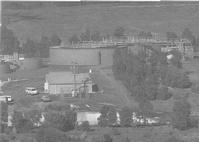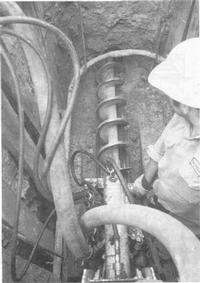


Chapter 6
I Construction During The Settlement Years
II The Use Of Timber As A Structural Material
III Structural Steel
IV Concrete Technology
V Housing
VI Industrialised Pre-cast Concrete Housing
VII Ports And Harbours
VIII Roads
IX Heavy Foundations
X Bridges
XI Sewerage
i Hydrogen Sulphide (HS) Attack
ii Property Services
iii Sewerage Reticulation
XII Water Engineering
XIII Railways
XIV Major Buildings
XV Airports
XVI Thermal Power Stations
XVII Materials Handling
XVIII Oil Industry
XIX The Snowy Mountains Scheme
XX The Sydney Opera House
XXI The Sydney Harbour Bridge
XXII Hamersley Iron
XXIII North West Shelf
Sources and References
Index
Search
Help
Contact us

Sewerage Reticulation
Separate or Combined SystemsAustralian pioneers for the most part opted for 'separate' systems where there is one system for sewerage and a quite separate one for surface storm water. In Sydney combined systems are being progressively phased out. With 'separate' systems, it is essential to keep surface water out of the sewers, in order to limit the hydraulic load on treatment plants, pumping stations and outfalls. The uniform codes and exchange of data adopted by Australian authorities have facilitated the reduction of infiltration by the use of the rubber-ring joint.
Sewerage Backlog and the Environment
The environment generally and the receiving waters of the surface run-off in particular suffered badly from the lack of sewer construction during the Second World War and periods of depression, and correction only really commenced in the 1960s, when land sub-dividers were required to provide sewers and other essential services in their sub divisions. To facilitate this service and treat the wastes before the ultimate transfer and treatment works could be provided, quite sophisticated 'neighbourhood' or 'package' activated sludge type sewerage treatment plants were developed. They have proved highly successful to the benefit of the community served and the environment at large (Fig. 36).

Another development to minimise the disruption and possible damage to existing buildings and services in back-log areas was the development of machines for boring from 150 mm up to 450 mm diameter holes in which to lay the reticulation pipes and thus avoid the need for trenching. This cost-saving, where the surface is occupied by an expensive development, such as a swimming pool, has proved substantial (Fig. 37).

Tunnelling
The pumping of sewerage, which is corrosive, contains intractable solids and has wide variation in flows, presents economic and technical problems. In order to establish gravity flow in main transfer sewers, it is often necessary to lay them below practical open-cut excavation limits, by tunnelling. Considerable advances have been made in Australia, in particular in Melbourne, in constructing sewer tunnels. In Melbourne alone, between 1967 and 1985, 135 km of large bore water supply and sewerage tunnels were constructed.
People in Bright Sparcs - Robertson, A. G.
 |
Australian Academy of Technological Sciences and Engineering |  |
© 1988 Print Edition pages 363 - 364, Online Edition 2000
Published by Australian Science and Technology Heritage Centre, using the Web Academic Resource Publisher
http://www.austehc.unimelb.edu.au/tia/365.html